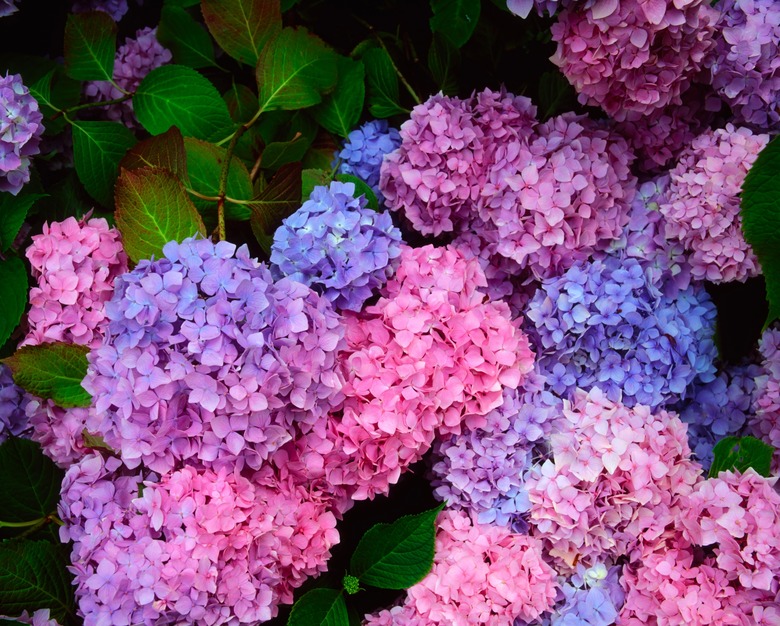Rhododendron Vs. Hydrangea
Hydrangeas (Hydrangea spp.) and rhododendrons (Rhododendron spp.) are showy, flowering shrubs that, in some cases, have evergreen leaves. They also share some preferences in terms of growing conditions. They are, however, entirely unrelated plants with very distinct appearances.
Rhododendron Genus
The genus Rhododendron includes the shrubs commonly called rhododendrons and azaleas. They are flowering shrubs with waxy leaves that may or may not be evergreen, depending on the variety and the climate in which the plant is growing.
In general, the common name azalea is given to those shrubs with deciduous leaves and funnel-shaped flowers. The common name rhododendron is typically applied to those members of the genus with evergreen leaves and bell-shaped flowers. Some azaleas are evergreen in warmer climates, however.
Rhododenron cultivars vary in terms of their winter hardiness. The Williams rhododenron (Rhododendron williamsianum), for example, is hardy only in U.S. Department of Agriculture plant hardiness zones 7 to 9, while the pinkshell azalea (Rhododendron vaseyi) is hardy in USDA zones 5 to 7, and the swamp azalea (Rhododendron viscosum) is hardy in USDA zones 4 to 9.
They also vary considerably in size. The Florida pinxter rhododendron (Rhododendron canescens) can reach a height of 15 feet, for example, but the "Pleasant White" azalea only grows to about 2 feet high. Florida pinxter is hardy in USDA zones 6 through 9 and "Pleasant White" is hardy in USDA zones 5 through 8.
Hydrangea Types
The hydrangea (Hydrangea macrophylla), also sometimes called the French hydrangea, is a flowering shrub that's hardy in USDA zones 6 to 10. It is typically deciduous, but it may be evergreen in warm climates. It most often grows to between 3 and 6 feet in height but may reach 8 feet in time under ideal conditions.
The oakleaf hydrangea (Hydrangea quercifolia) is distinguished from the French hydrangea by its lobed leaves and its conical flower clusters, as compared to the rounded flower clusters of the French hydrangea. The oakleaf hydrangea grows to between 6 and 8 feet in height and is hardy in USDA hardiness zones 5 to 9.
Soil Acidity
Both rhododendrons and hydrangeas are sensitive to soil pH, and both grow best in acidic soils with a pH level between 5 and 5.5. Hydrangeas, however, are less sensitive and will tolerate soils with a higher pH.
The flowers of French hydrangea will vary depending on the pH of the soil in which the shrub is growing. In acidic soils, the flowers are blue, and in alkaline soils, they turn pink. In neutral soils, the flowers are white or pale green. The color of rhododendron flowers is unaffected by soil pH.
Growing Conditions
Aside from soil acidity, hydrangeas and rhododendrons are similar in their other cultural requirements, as well. Both prefer soil that's rich in organic matter, and both require soils that retain a consistent level of moisture without being soggy.
Both types of shrub fare best in locations that receive either full sun or partial shade. Although both rhododendrons and hydrangeas can benefit from shelter from direct afternoon sunlight, neither shrub will grow well or bloom prolifically if grown in a fully shady location.
References
- Floridata: Hydrangea Macrophylla
- Missouri Botanical Garden: Hydrangea Quercifolia
- Chicago Botanic Garden: Hydrangea
- Missouri Botanical Garden: Rhododendrons and Azaleas
- Missouri Botanical Garden: Rhododendron 'Maxecat'
- Missouri Botanical Garden: Rhododendron 'Pleasant White'
- Fine Gardening: Rhododendron
